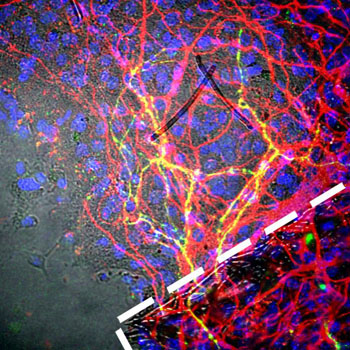3D Network Structures Improve Survival of Transplanted Stem Cell-Derived Neurons
By LabMedica International staff writers
Posted on 27 Mar 2016
Neurological disease researchers have developed a method for treating neurodegenerative diseases such as Parkinson's by transplanting three-dimensional (3D) networks of stem cell-derived neurons into the damaged brain tissue.Posted on 27 Mar 2016
Cell replacement therapy using human pluripotent stem cell-derived neurons has the potential to correct neurodegenerative damage and central nervous system injuries, but transplantation of dissociated and spatially disorganized neurons portends poor cell survival and incomplete functional development.

Image: Reprogrammed human neurons grown on 3D scaffolds (within the white dash line) and transplanted onto brain tissue (red) extended out (yellow lines) and integrated (Photo courtesy of Neal K. Bennett, Moghe Laboratory, Rutgers University).
Investigators at Rutgers University (Piscataway, NJ, USA) and Stanford University (Palo Alto, CA, USA) recently described the design of three-dimensional scaffolds based on tunable electrospun microfibrous polymeric substrates. These scaffolds promoted in situ stem cell neuronal reprogramming, neural network establishment, and supported neuronal engraftment into the brain.
The investigators reported in the March 17, 2016, online edition of the journal Nature Communications that they had successfully grafted scaffold-supported, reprogrammed neuronal networks into organotypic hippocampal brain slices. This approach yielded an approximately 3.5-fold improvement in neurite outgrowth and increased action potential firing relative to injected isolated cells. Transplantation of scaffold-supported neuronal networks into mouse brain striatum improved survival by about 38-fold at the injection site relative to injected isolated cells, and allowed delivery of multiple neuronal subtypes.
"If you can transplant cells in a way that mimics how these cells are already configured in the brain, then you are one step closer to getting the brain to communicate with the cells that you are now transplanting," said senior author Dr. Prabhas V. Moghe, professor of biomedical, chemical, and biochemical engineering at Rutgers University. "In this work, we have done that by providing cues for neurons to rapidly network in three dimensions."
Related Links:
Rutgers University
Stanford University













